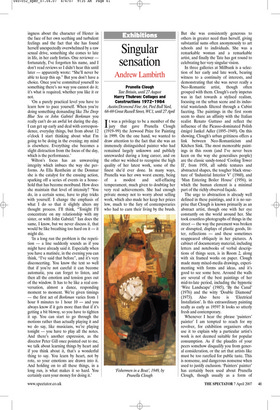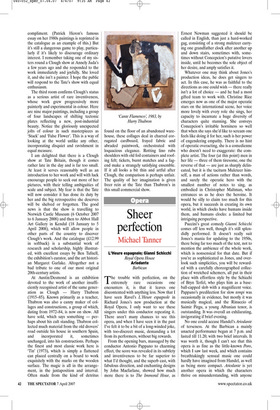Singular sensation
Andrew Lambirth
Prunella Clough Tate Britain, until 27 August Harry Thubron: Collages and Constructions 1972–1984 Austin/Desmond Fine Art, Pied Bull Yard, 68–69 Great Russell Street, WC1, until 27 April
It was a privilege to be a member of the jury that gave Prunella Clough (1919–99) the Jerwood Prize for Painting in 1999. On the one hand, we wanted to draw attention to the fact that she was an immensely distinguished painter who had remained largely unknown and publicly unrewarded during a long career, and on the other we wished to recognise the high quality of her latest work, some of the finest she’d ever done. In many ways, Prunella was her own worst enemy, being of a modest and self-effacing temperament, much given to doubting her very real achievements. She had enough private money not to worry about selling work, which also made her keep her prices low, much to the fury of contemporaries who had to earn their living by the brush. But she was consistently generous to others in greater need than herself, giving substantial sums often anonymously to art schools and to individuals. She was a remarkable woman and a remarkable artist, and finally the Tate has got round to celebrating her very singular vision.
In three galleries at Millbank is a selection of her early and late work, bearing witness to a continuity of interests, and demonstrating that she was never really a Neo-Romantic artist, though often grouped with them. Clough’s early impetus was in fact towards a stylised realism, focusing on the urban scene and its industrial wastelands filtered through a Cubist faceting. The paintings in the first room seem to share an affinity with the Italian realist Renato Guttuso and reflect the influence of the Picasso-dominated Polish émigré Jankel Adler (1895–1949). On this showing, Clough’s urban grittiness offers a link between Neo-Romanticism and Kitchen Sink. The most memorable paintings in this room (and I’ve never been keen on the way she generalises people) are the classic sandy-toned ‘Cooling Tower II’, from 1958, all subtle textures and abstracted shapes, the tougher black structure of ‘Industrial Interior V’ (1960), and ‘Man Entering Boiler House’ (1956), in which the human element is a minimal part of the richly observed façade.
The urge to abstraction is already well defined in these paintings, and it is no surprise that Clough is known primarily as an abstract artist, though one with her eye constantly on the world around her. She took countless photographs of things in the street — the way the pavement was broken or disrupted, displays of plastic goods, litter, reflections — and these sometimes reappeared obliquely in her pictures. A cabinet of documentary material, including letters and notebooks of verbal descriptions of things seen, is in Room 2, along with six framed works on paper. Clough made many mixed-media drawings, experimenting with forms and ideas, and it’s good to see some here. Around the walls are several of the best paintings of her mid-to-late period, including the hypnotic ‘Wire Landscape’ (1985), ‘By the Canal’ (1976) and the witty ‘Double Diamond’ (1973). Also here is ‘Electrical Installation’. Is this extraordinary painting really as early as 1959? It looks so utterly fresh and contemporary.
Whenever I hear the phrase ‘painters’ painter’ I am tempted to reach for my revolver, for exhibition organisers often use it to explain why a particular artist’s work is not deemed suitable for popular consumption. As if the plaudits of your peers somehow disqualify you from general consideration, or the art that artists like must be too rarefied for public taste. This is nonsense, and dangerous nonsense when used to justify exclusion. ‘Painters’ painter’ has certainly been used about Prunella Clough, though usually as a form of compliment. (Patrick Heron’s famous essay on her 1980s paintings is reprinted in the catalogue as an example of this.) But it’s still a dangerous game to play, particularly if it’s likely to discourage ordinary interest. I remember taking one of my sisters round a Clough show at Annely Juda’s a few years ago and she responded to the work immediately and joyfully. She loved it, and she isn’t a painter. I hope the public will respond to the Tate’s show with equal enthusiasm.
The third room confirms Clough’s status as a serious artist of rare inventiveness, whose work grew progressively more painterly and experimental in colour. Here are nine major paintings, including a group of four landscapes of shifting tectonic plates reflecting a new, post-industrial beauty. Notice the gloriously unexpected jolts of colour in such masterpieces as ‘Stack’ and ‘False Flower’. This is a way of looking at the world unlike any other, incorporating disquiet and ravishment in equal measure.
I am delighted that there is a Clough show at Tate Britain, though it comes rather late in the day and is far too small. At least it serves reasonably well as an introduction to her work and will with luck encourage people to seek out more of her pictures, with their telling ambiguities of scale and subject. My fear is that the Tate will now consider it has done its duty by her and the big retrospective she deserves will be shelved or forgotten. The good news is that the show is travelling to Norwich Castle Museum (6 October 2007 to 6 January 2008) and then to Abbot Hall Art Gallery in Kendal (18 January to 5 April 2008), which will allow people in other parts of the country to discover Clough’s work. And the catalogue (£12.99 in softback) is a substantial work of research and scholarship, highly illustrated, with excellent essays by Ben Tufnell, the exhibition’s curator, and the art historian Margaret Garlake. Altogether not a bad tribute to one of our most original 20th-century artists.
At Austin/Desmond is an exhibition devoted to the work of another insufficiently recognised artist of the same generation as Clough — Harry Thubron (1915–85). Known primarily as a teacher, Thubron was also a canny maker of collages and constructions, a group of which, dating from 1972–84, is now on show. All have sold, which says something — perhaps about his cult standing. Thubron collected much material from the old drovers’ road outside his house in southern Spain, and incorporated it, sometimes unchanged, into his constructions. Perhaps the finest and most classic work here is ‘Tin’ (1973), which is simply a flattened can placed centrally on a board to work exquisitely with the marks on the wooden surface. The magic is all in the arrangement, in the juxtaposition and interval. Often made from the kind of detritus found on the floor of an abandoned warehouse, these collages deal in charred corrugated cardboard, frayed fabric and abraded paintwork, orchestrated with loquacious elegance. Rotting lino rubs shoulders with old foil containers and roofing felt; tickets, burnt matches and a fagend make a strangely satisfying ensemble. If it all looks a bit thin and artful after Clough, the comparison is perhaps unfair. The quality of her imagination is given freer rein at the Tate than Thubron’s in this small commercial show.



































































 Previous page
Previous page